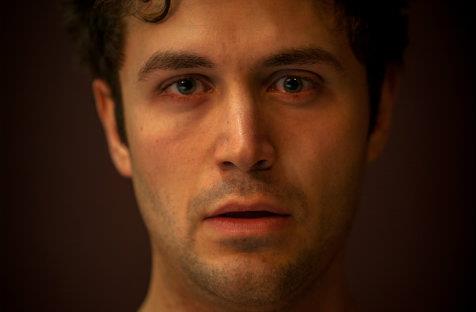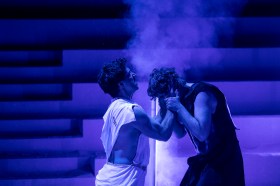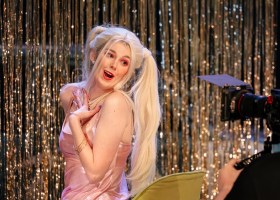As many readers will know, Wake In Fright is a seminal 1961 Australian novel adapted into an Australian New Wave classic in 1971. The story of a young school teacher’s flight into hell, thanks to the grotesque inhabitants of the town of Bundanyabba where he is stranded after losing all his money in a two-up game, is still considered one of the most terrifying films of the period; an ugly look at Australia and the Outback. With this importance in play, you’d reason it should make for a rather unsettling, disturbing and ultimately thrilling night of theatre.
Why then does Renee Palmer’s production feel more of a curiosity than gripping drama? There are elements to be respected about the presentation of Bob Pavlich’s taut script. David Wright’s evocative music thrust us into the searing Outback and fought hard to convey a sense of isolation, desperation and even moments of terror. The set, with its red dirt, rustic furniture and disheveled backcloths were utilised well by cast and director for the myriad of scenes, with tables and chairs creating cars and pubs in the blink of an eye. Some of the performances, particularly from Kristin Holland, Kurt Mottershead, Stu Duffield and especially Phil Roberts displayed the dynamic energy and understanding required to establish a clarity of time, place and culture. The philosophy of drinking beer was nicely realised and started out as an amusing gag but quickly defined itself as an ominous threat to our hero’s psyche. Lighting designer Patrick Neff, with a modest plot, still managed to take us swiftly from one location to the next while skillfully maintaining the mood and momentum.
Yet his projections were muted and unnecessary, a notable distraction from the primary action. This summed up what didn’t seem to work in this production. Emotional impact, the sense of dread and desperation, the menace of the people of this strange town, pace and, ultimately, a truth to the piece – all muted.
To begin with, there wasn’t a lot of variety between some characterisations, despite the aforementioned energy. The men generally were far more successful than the women. And it felt like an older woman’s presence was missing from the piece. Adults need to be careful with overacting when playing children. Some of the children portrayed looked like they were short of a marble or two.
Other issues included modern watches, pens and costumes in amongst period-style garb. Those finishing touches can really make a difference between being immersed in story and being snapped sharply into reality. Paul Knox, whilst giving a brave performance, was too mellow to truly be a ‘character’ of the town. He still needed an edge. Sophie Petridis, while definitely looking the part, was also too soft, thus rendering her character bland.
What was missing the most from this production was the edge-of-your-seat experience that was needed to honour the work. Despite valiant attempts from some of the actors, that looked on occasion like they were trying too hard, the end result felt lackluster and pointless. Where was the building of tension? Why did we not care for the main character’s plight?
The overall production looked slick and moved with style but something thrilling was missing. Here we need to question the motives of the director and the performance of her leading man. The director states in her program notes that she didn’t just want to portray the townspeople as mean and nasty but also vulnerable. While this seems like an honorable gesture, the result included some one-dimensional portrayals from an obviously talented troupe that was frustrating to watch. The dramatic moment between Tydon and Grant was merely uncomfortable to witness – disturbing and gut-wrenching should have been the goal.
James Harvey as our protagonist, John Grant, seemed stilted to begin with, and, despite the obvious emotion in his eyes, appearing merely upset by the end of the play as opposed to traumatised and broken. His journey, as portrayed by Harvey, was not momentous, merely diverting. The director and actor didn’t seem to find the play’s spirit, thus losing any sense of truth and connection with the audience. The best moment of the play, by a country mile, was the staging of the two-up game. Here was a rare example where everything came together and it seemed, briefly, that we were in for an exciting ride. But the play ended with a whimper and a shrug.
Go to celebrate some sterling performances and the adaptation itself, as it’s written with care and loyalty to the source, but wonder what it could be like with a different take and more focus on what was important.
Rating: 2 stars out of 5
Wake in Fright
Adapted by Bob Pavlich from the novel by Kenneth Cook
Directed by Renee Palmer
Based on the original production directed by Bob Pavlich
Assistant Director / Dramaturge: Matthew Sharawara
Beth Myring, David Wright (Music)
Lighting designer/ film designer: Patrick Neff
Set Designer: Darren Lever
Performed by James Harvey, Paul Knox, Kurt Mottershead,
Phil Roberts, Sophie Petridis, Stuart Duffield, Kristin Holland,
La Mama Courthouse, Carlton
10 – 28 July






